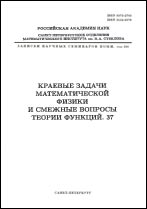|
|
Zapiski Nauchnykh Seminarov POMI, 1992, Volume 201, Pages 157–163
(Mi znsl5110)
|
 |
|
 |
This article is cited in 4 scientific papers (total in 4 papers)
Boundary distortions and change of module under extension of a doubly connected domain
A. Yu. Solynin
Abstract:
Let $\mathcal{F}(p,r)$ denote the class of univalent analytic functions
$f(z)$ in the domain $\mathcal{K}(\rho)=\{z: \rho<|z|<1\}$, satisfying
$|f(z)|=1$ for $|z|=1$ and $r<|f(z)|<1$ for $z\in\mathcal{K}(\rho)$. Let
$f(z;\rho,r)$ map $\mathcal{K}(\rho)$ onto the domain $\mathcal{K}(r)\setminus[r,s]$ and let
$f(z;\rho,r)\in\mathcal{F}(\rho,r)$.
THEOREM 2. Let $f(z)\in\mathcal{F}(\rho,r)$, $f(z)\ne e^{i\alpha}f(z;\rho,r)$, $\alpha\in\mathbb{R}$,
and $\Phi(t)$ be a strictly convex monotone function of $t>0$. Then
$$
\int_0^{2\pi}\Phi(|f'(e^{i\theta})|)d\theta<\int_0^{2\pi}\Phi(|f'(e^{i\theta};\rho,r)|)d\,\theta.
$$
The proof of this theorem is based on the Golusin–Komatu equation.
If $E$ is a continuum in the disk $U_R=\{z: |z|<R\}$, then
$M(R,E)$ denotes the conformal module of the doubly connected
component of $U_R\setminus E$;
let $\varepsilon(m)=\{E: \overline{U}_r\subset E\subset U_1,\ M(1, E)=m^{-1}\}$.
PROBLEM. Find the maximum of $M(R, E)$, $R>1$, and the minimum
of cap $E$ over all $E$ in $\varepsilon(m)$. This problem was posed by
V. V. Koževnikov in a lecture to the seminare on geometric function
theory at the Kuban university in 1980, and by D. Gaier (see [2]).
The solution of this problem is given by the following theorem.
THEOREM 3. Let $E^*=\overline{U}_m\cup[m, s]$. If $R>1; E, E^*\in\varepsilon(m)$
and $E\ne e^{i\alpha}E^*$, $\alpha\in\mathbb{R}$, then
$$
M(R, E)<M(R,E^*),\quad \mathrm{cap}\,E^*<\mathrm{cap}\,E.
$$
A similar statement is also proved for continue lying in the half-plane.
ADDENDUM. When the paper was ready for publication, the
author obtained a letter from R. Laugesen with the information
that he had also proved Theorem 3 by a different method based on
results of A. Baernstein. II on potential theory.
Citation:
A. Yu. Solynin, “Boundary distortions and change of module under extension of a doubly connected domain”, Investigations on linear operators and function theory. Part 20, Zap. Nauchn. Sem. POMI, 201, Nauka, St. Petersburg, 1992, 157–163; J. Math. Sci., 78:2 (1996), 218–222
Linking options:
https://www.mathnet.ru/eng/znsl5110 https://www.mathnet.ru/eng/znsl/v201/p157
|

| Statistics & downloads: |
| Abstract page: | 166 | | Full-text PDF : | 44 |
|




 Contact us:
Contact us: Terms of Use
Terms of Use
 Registration to the website
Registration to the website Logotypes
Logotypes








 Citation in format
Citation in format 
